Portsmouth
The tidal estuary of the Piscataqua River is an excellent natural harbour, so it is not surprising that it was where the first colonists arrived under the 1623 land grant given to Captain John Mason. The original settlement was near the mouth of the river, but in 1630 English colonists settled on the west bank of the harbour. Seeing that the site was covered in wild strawberries, they named their settlement Strawbery Banke. The it grew rapidly as a port with fishing and shipbuilding as major industries as well as the shipping of timber harvested inland. Fort William and Mary was built to protect the settlement. When the settlement became and incorporated town in 1653 it was named Portsmouth because Captain John Mason had been captain of the port of Portsmouth in England. Normally colonists didn’t seem to worry about whether there was any similarity between a settlement and its British namesake, the names of British ports were given to settlements well in land and vice versa. In this case the name was very appropriate because both Portsmouths are located on large natural harbours. After the Revolutionary War, Portsmouth’s growth stuttered due to an 1807 embargo on trade with Britainbut then came the War of 1812 with its Privateering opportunities. The industrial revolution saw Portsmouth go into permanent decline as the mills were built inland where there was plenty of water power. Many of the buildings from Portsmouth’s boom times are still standing so the modern city has a wealth of historic buildings.
Temple Israel, State Street
As a major port, Portsmouth attracted many immigrants and with them came a variety of religions. The first record of a Jewish family living in Portsmouth dates back to 1780. By the beginning of the 20th century there were about 30 Jewish families living in the city but they had nowhere other than private homes in which to hold religious services. In 1910 they formed Temple Israel as a legally recognised religious group. An early priority was to find a building to use as a Synagogue, and a solution emerged in 1911 when the Methodists put their Church on State Street up for sale. By the fall of 1912 the former Church was up and running as a Synagogue. Temple Israel Synagogue is still in active use today serving nearly 300 families.
Jefferson St at Atkinson St, Strawbery Banke Museum
Strawbery Banke, the original name of Portsmouth, has come back to life in the form of a 4 hectare (10 acre) outdoor history museum in downtown Portsmouth. Here 39 historic buildings have been preserved, most standing on their original foundations. The earliest building dates back to 1695. In the 19th century Puddle Dock was an area of Portsmouth with a high proportion of immigrants, but by the 1950s it had become run down. In 1958 the museum purchased the site and its original buildings to create the outdoor living history museum. In this picture the Peacock House is on the left, the Yeaton House in the centre and on the right is the Ethnobotanical Garden overlooked by the Cotton Tenant House. Strawbery Banke Museum is open 7 days a week from May to October. Click Tab 2 to see the Sherburne House which dates back to around 1695.
Aldrich House, Strawbery Banke Museum
This house was built around 1797 but it is not known who built it. Thomas Bailey Aldrich was an American poet and author who grew up mainly in New Orleans and New York City. Between 1849 and 1852 he lived with his grandparents in this house. Memories of his time in Portsmouth stayed with him and he subsequently wrote two books that featured the city: ‘The Story of a Bad Boy’ and ‘An Old Town by the Sea’. Aldrich died on March 19, 1907 and a few months later the Thomas Bailey Aldrich Memorial Association purchased the house. They restored it to the time period when Aldrich lived here as a boy, and opened it as a memorial museum. The Aldrich House became part of Strawbery Banke Museum in 1979. Click Tab 2 to see a bedroom in the house.
Carriage passing Warner House, Daniel Street
Scots-Irish sea captain and merchant Archibald Macpheadris had this Georgian brick house built in 1716. Macpheadris died in 1729, leaving the house to his wife Sarah and their children. They lived in the house until 1737 when Sarah remarried and moved to a house further up Daniel Street. Sarah’s brother Benning Wentworth moved into the house. He became the first Royal Governor of the Province of New Hampshire in 1741, so the house became for a time the Governor's Mansion. He lived in the house for nearly 20 years before moving to the Wentworth-Coolidge Mansion (see below). Macpheadris's only surviving child Mary married merchant Jonathan Warner in 1760 and they moved into the house. The house remained in the family until the early 1930s although from the 1880s it was used only as a summer residence. When the house was put up for sale an oil company tried to by it to replace it with a gas station. In 1931 Edith Greenough Wendell and a group of other preservationists set up the Warner House Association to try to save it. They purchased the house in 1932 and opened it as a largely unfurnished historic house museum. Over the years the house has been furnished with period pieces including many that were once owned by the family. The Warner House is open to the public daily excluding Tuesdays from June to October.
DLU180226
Wentworth-Coolidge Mansion
This clapboard house on the waterfront south east of the centre of Portsmouth was built for Royal Governor of the Province of New Hampshire Benning Wentworth in 1750. The mansion has an unusual appearance because it was made from a number of existing buildings that were moved to the site and joined together. The 40-room mansion served as Wentworth’s home and offices as well as the nerve centre of a working 40 hectare (100 acre) farm. The mansion was acquired by the Cushing family in 1816, who in the 1840s opened it to the public as an historic house. In 1886, John Templeman Coolidge III and his wife purchased the mansion and restored it with the assistance of Sumner Appleton, founder of the Society for the Preservation of New England Antiquities. Coolidge was an amateur artist and trustee of the Boston Museum of Fine Arts, so many renowned artists visited the mansion. Coolidge died in 1945. In 1954 the Coolidge family gave the Mansion and its surrounding lands to the State of New Hampshire. The grounds of the Wentworth-Coolidge Mansion are open daily year-round while the house is open in season for guided tours. Click Tab 2 to see the parlor
Click on Minimap to navigate
Home > US States > New England > New Hampshire >
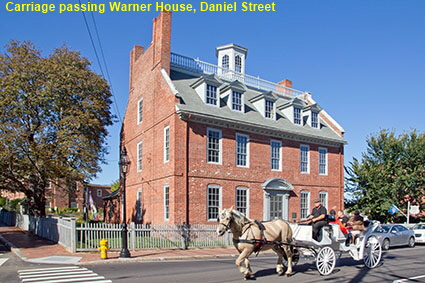
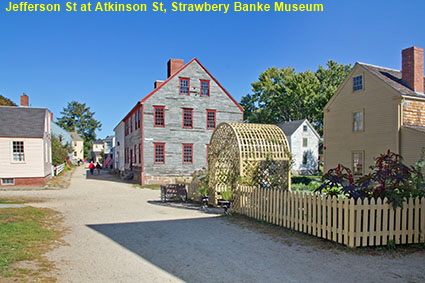
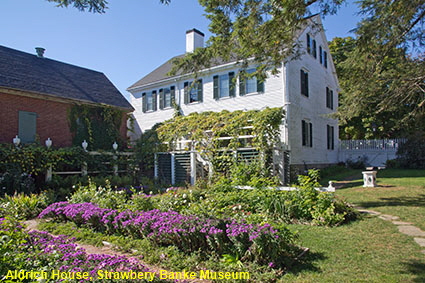
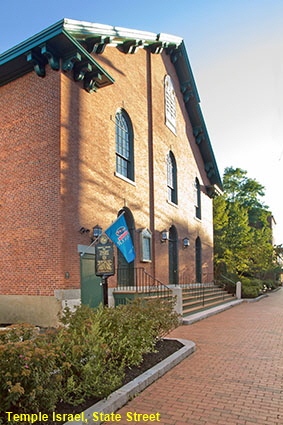
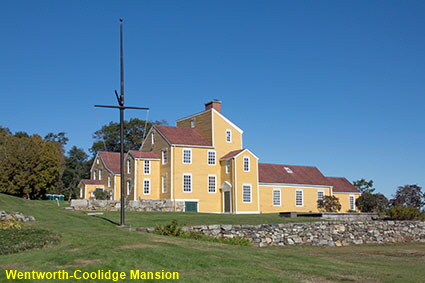


To move forwards or backwards through the New Hampshire trail click the arrows above, or select your next destination on the Minimap.
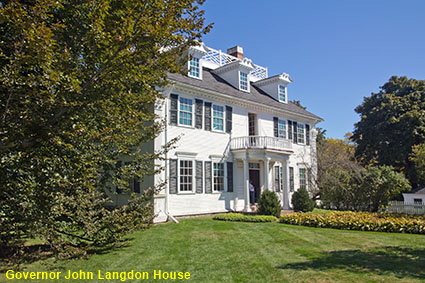
Governor John Langdon House
John Langdon was born in 1741, a descendent of a family who emigrated from Cornwall in the mid 17th century. By the age of 22 he was captain of a ship and by age 26 he owned his own ship. By the start of the Revolutionary War he had a small fleet of merchantmen and was very wealthy. He disliked the control that Britain exerted over shipping and trade, so during the Revolutionary War he was an ardent supporter of independence. After the war he entered politics, serving as a US senator and three-term governor of New Hampshire. In 1784 Langdon built a mansion in Portsmouth and following his death in 1819 it passed to his daughter. She did not live permanently in the mansion and in 1833 she sold it. It passed through several hands and in the 1850s the mansion was damaged by fire. In 1877 Woodbury Langdon, a descendant of John Langdon’s brother Woodbury, purchased the house as a home for his mother, Frances Bassett Woodbury. After she died in 1902, the mansion was converted into a Colonial Revival showplace, adding a two-story wing designed to match the original structure. Since 1947 the Governor John Langdon House has been opened to the public as a museum by Historic New England. Tours are available from June to mid October.
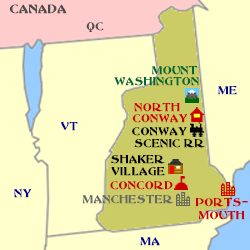

© Mike Elsden 1981 - 2025
The contents of this page may not be reproduced in full or in part without permission